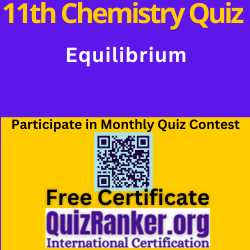Test your understanding of chemical equilibrium with our free, chapter-wise MCQ quiz for 11th grade Chemistry. Improve your exam preparation and concept clarity.
Test Chemistry Equilibrium chapter wise MCQ
View Chapter wise MCQ Quiz of 11th Chemistry
Chapter of 11th Chemistry Chapter Wise MCQ
Unit 1 Some Basic Concepts of Chemistry
1.1 Importance of Chemistry
1.2 Nature of Matter
1.3 Properties of Matter and their Measurement
1.4 Uncertainty in Measurement
1.5 Laws of Chemical Combinations
1.6 Dalton’s Atomic Theory
1.7 Atomic and Molecular Masses
1.8 Mole Concept and Molar Masses
1.9 Percentage Composition
1.10 Stoichiometry and Stoichiometric Calculations
Unit 2 Structure of Atom
2.1 Discovery of Sub-atomic Particles
2.2 Atomic Models
2.3 Developments Leading to the Bohr’s Model of Atom
2.4 Bohr’s Model for Hydrogen Atom
2.5 Towards Quantum Mechanical Model of the Atom
2.6 Quantum Mechanical Model of Atom
Unit 3 Classification of Elements and Periodicity in Properties
3.1 Why do we Need to Classify Elements ?
3.2 Genesis of Periodic Classification
3.3 Modern Periodic Law and the Present Form of the Periodic Table
3.4 Nomenclature of Elements with Atomic Numbers > 100
3.5 Electronic Configurations of Elements and the Periodic Table
3.6 Electronic Configurations and Types of Elements: s-, p-, d-, f- Blocks
3.7 Periodic Trends in Properties of Elements
Unit 4 Chemical Bonding and Molecular Structure
4.1 Kössel-Lewis Approach to Chemical Bonding
4.2 Ionic or Electrovalent Bond
4.3 Bond Parameters
4.4 The Valence Shell Electron Pair Repulsion (VSEPR) Theory
4.5 Valence Bond Theory
4.6 Hybridisation
4.7 Molecular Orbital Theory
4.8 Bonding in Some Homonuclear Diatomic Molecules
4.9 Hydrogen Bonding
Unit 5 Thermodynamics
5.1 Thermodynamic Terms
5.2 Applications
5.3 Measurement of ÄU and ÄH: Calorimetry
5.4 Enthalpy Change, ÄrH of a Reaction – Reaction Enthalpy
5.5 Enthalpies for Different Types of Reactions
5.6 Spontaneity
5.7 Gibbs Energy Change and Equilibrium
Unit 6 Equilibrium
6.1 Equilibrium in Physical Processes
6.2 Equilibrium in Chemical Processes – Dynamic Equilibrium
6.3 Law of Chemical Equilibrium and Equilibrium Constant
6.4 Homogeneous Equilibria
6.5 Heterogeneous Equilibria
6.6 Applications of Equilibrium Constants
6.7 Relationship between Equilibrium Constant K, Reaction Quotient Q and Gibbs Energy G
6.8 Factors Affecting Equilibria
6.9 Ionic Equilibrium in Solution
6.10 Acids, Bases and Salts
6.11 Ionization of Acids and Bases
6.12 Buffer Solutions
6.13 Solubility Equilibria of Sparingly Soluble Salts
Study Source:
Total Views: 7


